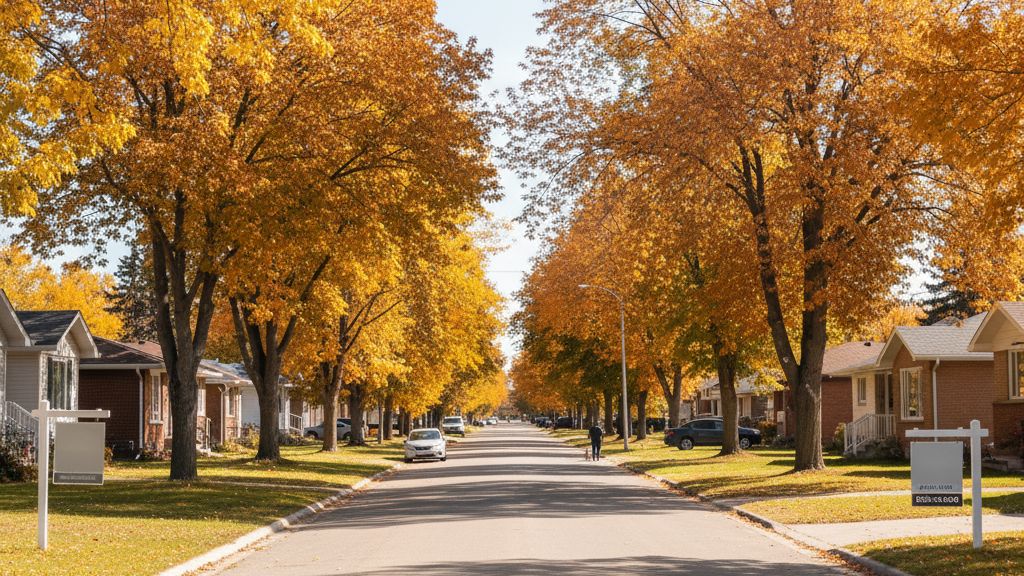
Is the Lakeland Real Estate Market Finally Balancing Out? 3 Big Signs for Buyers and Sellers in Fall 2025
For the last few years, the Lakeland real estate market has been a story of speed and scarcity. It’s been a sprint for buyers and a whirlwind for sellers. If you’ve been holding your breath, waiting for a calmer moment to make your move, it’s finally time to exhale. As we head into the fall of 2025, a welcome and healthy sense of equilibrium is returning to St. Paul, Bonnyville, and our surrounding communities.
This shift isn’t a downturn or a crash; it’s a market normalization. It’s the market’s natural way of moving from the extreme, fast-paced conditions that heavily favoured sellers toward a more balanced state, one where both buyers and sellers can make thoughtful, confident decisions without intense pressure.
Our goal here is simple: to provide clear, honest insights to empower your family’s decisions. So, let’s explore what a balanced market really is, look at the three biggest signs that it’s happening right now, and most importantly, discuss what it truly means for you and your family right here in the Lakeland.
First, What Is a “Balanced Market” and Why Is It Good for the Lakeland?

In simple terms, a balanced market is where the number of homes for sale is roughly equal to the number of buyers looking to purchase. Think of it like a seesaw that’s perfectly level.
Neither side has a significant advantage, leading to more stable prices, reasonable timelines, and the return of fair, traditional negotiations. This shift is a sign of a mature, healthy market—exactly the kind of stability that builds long-term community value.
The two key indicators of a balanced market are:
- A Sales-to-New-Listings Ratio (SNLR) between 40% and 60%: A ratio above 60% indicates a seller’s market, while below 40% suggests a buyer’s market. In a balanced market, every two homes that hit the market, one is sold.
- A “Months of Inventory” (MOI) between 4 and 6 months: This figure tells us how long it would take to sell all available inventory at the current rate of sales. Less than four months suggests a seller’s market, and more than six months signals a buyer’s market.
Now, let’s dive into the three biggest signs that our local market is trending toward this healthy state.
Sign #1: The Return of Manageable Housing Supply
One of the most frustrating aspects of the recent market has been the lack of available homes. Thankfully, we’re seeing an encouraging shift.
According to the latest data from the Alberta Real Estate Association (AREA), active residential listings across Alberta’s key regions are up. This increase in inventory is the most important sign of a normalizing market because it gives buyers more time to explore their options and reduces the frantic pressure that has defined the last few years. More choices mean more confidence.
What this really looks like in St. Paul & Bonnyville: This trend gives our local buyers significant choice. As of today, there are over 56 active listings in the Town of St. Paul and nearly 57 listings in the Town of Bonnyville, as of the date of this blog. For the first time in a long time, you truly have the power of choice.

Sign #2: The Return of Due Diligence (Normalizing Sales Timelines)
For a long time, buying a home felt like a high-speed chase. But the days of “offer tonight or it’s gone” are fading as the market finds a healthier rhythm. The average days on market (DOM) for residential properties in the Greater Edmonton Area is now 37 days, an increase of 4 days from the previous month. This measured pace gives serious buyers more time to arrange financing, conduct inspections, and feel confident about their purchase—all things that lead to a better home-buying experience.
What this really looks like in the Lakeland: Our local pace provides a distinct advantage for buyers. The average days on market is currently 111 days in the Town of Bonnyville and 79 days in the Town of St. Paul (stats referenced from within past 30 days of this post). This measured pace means you can make an offer conditional on financing and a home inspection without the intense pressure found in major cities. It’s a massive win for buyer safety and confidence.
Sign #3: The Return of Stability & Healthy Market (Sustained Price Growth)
After a period of rapid appreciation, our local market is demonstrating continued health. The regional report shows a sustained and healthy 5% year-over-year increase in the total residential average price. This is not a bubble, but a sign of a strong local economy and continued demand. It reinforces that investing in our community is a smart, long-term decision.
What this really looks like in the Lakeland: The average home price is holding strong at approximately $236,000 in the Town of St. Paul and $292,000 in the Town of Bonnyville. For those seeking more space, the average acreage price is around $265,000 in St. Paul County and $544,900 in the M.D. of Bonnyville in the past 30 days. This data gives buyers confidence they aren’t purchasing at a temporary peak and provides sellers with a clear picture of their home’s strong value.
The ‘Golden Window’: Why a Balanced Market Is a Unique Opportunity
It’s tempting to see a normalizing market as a time to “wait and see,” but in reality, it often presents a rare and valuable window of opportunity for both savvy buyers and sellers. It’s a moment of clarity between the frenzy of a seller’s market and the uncertainty of a buyer’s market.

Market Conditions at a Glance:
| Feature | Seller’s Market | Balanced Market (Today) | Buyer’s Market |
| Inventory | Very Low 📉 | Adequate ↔️ | High 📈 |
| Buyer Competition | High 🔥 | Moderate 👍 | Low ❄️ |
| Price Trend | Rapid Increases 🔼 | Stable / Modest Growth ✅ | Stable / Potential Declines 🔽 |
| Negotiating Power | Favours Seller | Equal Footing | Favours Buyer |
| Key Feeling | Frenzy & Urgency | Calm & Confidence | Caution & Hesitation |
This “golden window” allows you to make a move based on logic and your family’s needs, not market-induced pressure.
Your Strategic Playbook for a Balanced Market
Navigating a balanced market isn’t just about timing; it’s about making smart, informed decisions that set you up for success. Here’s a deeper look at the strategies that will help you win.
The Lakeland Buyer’s Playbook: How to Secure Your Perfect Home
- Solidify Your Financial Power First. In a balanced market, a seller will favour a confident offer over an uncertain one. Walking in with a mortgage pre-approval is the single most powerful negotiating tool you have. It shows you’re a serious, qualified buyer and gives you a firm budget to work with. If you’re new to this, it’s worth understanding the mortgage pre-approval process before you even start looking at listings.
- Master the Art of the Smart Offer. Negotiation is back, but it’s not just about offering a lower price. A strategic offer might include flexible closing dates that suit the seller’s timeline, or it might be a clean, confident offer with few conditions. Most importantly, it means reintroducing critical protections like financing and home inspection clauses. This ensures you’re buying a sound investment, not just a house.
- Think Like an Inspector During Showings. With more time on your side, you can look beyond the surface. Pay attention to the details during your showings. Look for signs of deferred maintenance like water stains under sinks, a worn-out roof, or an aging furnace. Identifying these potential costs upfront can inform your offer and prevent costly surprises down the road.
The Lakeland Seller’s Playbook: How to Maximize Your Return
- Price Ahead of the Market, Not Behind It. This is the most critical strategy in a balanced market. Buyers have time to watch listings, and an overpriced home that requires a price drop weeks later is often stigmatized. A strategic, data-driven price right from day one captures the attention of serious buyers immediately and creates a sense of value and urgency.
- Win the “Digital Curb Appeal” Battle. The first showing no longer happens at your front door; it happens online. Buyers are comparing dozens of listings on their phones. This is where investing in presentation pays off. This doesn’t necessarily mean a major overhaul. As we discuss in our guide, sometimes the smartest move is to focus on smart, small upgrades before selling. Professional photography is non-negotiable; it’s what gets buyers to book a showing in the first place.
- Neutralize Objections Before They Happen. In a competitive market, you want to remove any reason for a buyer to hesitate. Being proactive is key. Have your Real Property Report (RPR) and utility bills ready. Better yet, if you know of a potential issue, consider addressing it. Our seller’s guide to handling unexpected repairs offers a framework for deciding what’s worth fixing to ensure a smooth, confident sale.

Answering Your Questions
A shifting market brings questions. Here are some of the most common ones we hear.
Q: Is 2025 a good time to buy a house in the Lakeland region?
A: For many, yes. A balanced market offers the “three C’s”: Choice, Conditions, and Confidence. You have more homes to choose from, you can include protective conditions, and you can be confident in the stability of your investment.
Q: If I’m a seller, have I missed the chance to get a high price?
A: Not at all. Prices are stabilizing at a high level, not dropping. It simply means that achieving that excellent price now requires the right strategy, presentation, and marketing, rather than just relying on a frantic market.
Q: What is a “Days on Market” stat, and why does it matter?
A: Days on market (DOM) is the number of days a property has been listed for sale. A longer DOM signals that the market is normalizing and not in a fast-paced “sprint.” It gives buyers more time to make a decision.
Q: What if I list my home and it doesn’t sell in the first 30 days?
A: In our current local market, with average days on market over 90 days, this is completely normal and not a cause for panic. A balanced market requires patience. The key is to have a proactive marketing plan that continues to attract new buyers over time.
Q: Is it better to sell my house in St. Paul before I buy a new one?
A: In a balanced market, it’s more feasible to make an offer on a new home with a “sale of your property” condition. This gives you security, but the best strategy depends on your personal financial situation. It’s a key part of the conversation to have with your financial advisor and real estate professional.
Q: As a buyer, should I wait for prices or interest rates to drop further?
A: Trying to time the market perfectly is often a losing game. The advantage of buying in a balanced market is the power of negotiation and choice you have right now. Waiting could mean facing more competition if rates do drop, eroding the very benefits that exist today.
Q: What is a Sales-to-New-Listings Ratio, and how does it affect me?
A: This ratio compares the number of homes sold to the number of new homes listed. It tells you how fast homes are selling. A ratio between 40-60% is a balanced market, giving both buyers and sellers a level playing field.
It All Starts with a Conversation
A balanced market isn’t a market to fear—it’s a market of opportunity. It’s a chance to make a move based on your family’s timeline and goals, not on market-induced pressure.
If you have questions about what this changing market means for your unique situation, the best place to start is always a simple, honest conversation.
Each office is independently owned and operated.

categories
Archive
- September 2025
- June 2025
- March 2025
- January 2025
- October 2024
- July 2024
- May 2024
- November 2023
- June 2023
- March 2023
- November 2022
- October 2022
- July 2022
- May 2022
- March 2022
- January 2022
- December 2021
- October 2021
- August 2021
- July 2021
- April 2021
- March 2021
- February 2021
- January 2021
- December 2020
- November 2020
- October 2020
- September 2020
- August 2020
- July 2020
- June 2020
- May 2020
- April 2020
- March 2020
- February 2020
- January 2020
- December 2019
- November 2019
- October 2019
- September 2019
- August 2019
- July 2019
- June 2019
- May 2019
- April 2019
- March 2019
- January 2019
- December 2018
- November 2018
- October 2018
- September 2018